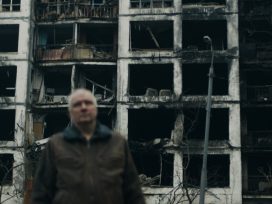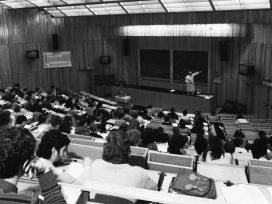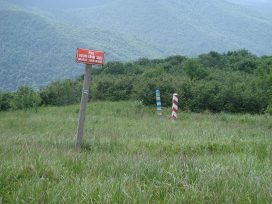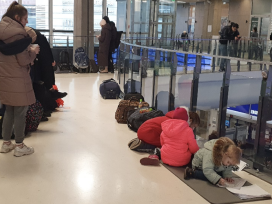The sound of resistance
From pop and rock to rap, metal and electronic: popular music in Ukraine has been a part of the national awakening since 2014. Now, once again, Ukrainian musical culture is under attack from Russia. But the music goes on, despite all odds, with artists contributing in different ways to the war effort.
It is 22 February 2022 and the Mariupol Theatre is full. Andriy Khlyvnyuk is on stage with his band BoomBox. Popular throughout Ukraine for two decades, the band’s songs fit every occasion: whether you are falling in love or breaking up, laughing or crying, in a stadium or at the front.
But this evening the atmosphere isn’t festive. In just over 24 hours Russia will invade Ukraine. No one knows that, of course, but there is a sense of dread. People gather on the city square in front of the Theatre, wrapped in Ukrainian flags, singing Ukrainian songs. Khlyvnyuk calls out to them: ‘Thank you for being you. For your integrity. For not being afraid. This is our home, and no one can chase us away. Let them try. Glory to Ukraine!’
The next evening, BoomBox raises people’s spirits at a gig in Melitopol. Late that night, on the way to the next city on the tour, the news reaches the band: Russia has attacked. Khlyvnyuk heads to Kyiv, brings his family to safety and swaps his microphone for an assault rifle. He volunteers for a fire support unit of the Kyiv police, now defending the city.
In the first few days, no one could think of music. The things that people had been listening to the day before became sounds from another life. A music that could express this new life was still inconceivable. Air-raid sirens, explosions, gunfire – this was the only soundtrack.
Three weeks later, Russia’s planes bombed Mariupol Theatre, where hundreds of civilians had sought refuge. Ten days after that, Andriy Khlyvnyuk came under mortar fire near Kyiv and was wounded in the face by shrapnel.
Destroyed and reborn
This is not the first time Russia has tried to destroy Ukrainian culture. The history of Ukraine is a history of thwarted beginnings and violently interrupted rebirths.
In the 20th century, Ukrainian composers, performers, researchers and educators were either persecuted and murdered, or incorporated into Moscow’s imperial system, so that they became representatives of a national minority. The diversity of Ukrainian music was reduced to a peasant stereotype. The repression of Ukrainian musicians reached its peak in the Stalinist purges of the 1930s, but began even earlier. In 1921, for example, Mykola Leontovych, a significant composer, choral conductor, pianist, and teacher and collector of folk songs, was shot dead by a Cheka agent.1
The destruction of the culture of Kobza and Bandura players marked a particular blow against Ukrainian musical traditions. Kobzars, often blind old men, had for centuries travelled from village to village with their string instrument, which resembles a lute. They were the creators, preservers and transmitters of the epic tradition of Duma (historical song), religious songs and fairy tales. The persecution of the Kobzars began with the Tsarist repression of all things Ukrainian towards the end of the 19th century. But it was only in the 1930s that this musical culture was destroyed completely. Under Stalin, Kobza and Bandura players were arrested, deported and murdered.
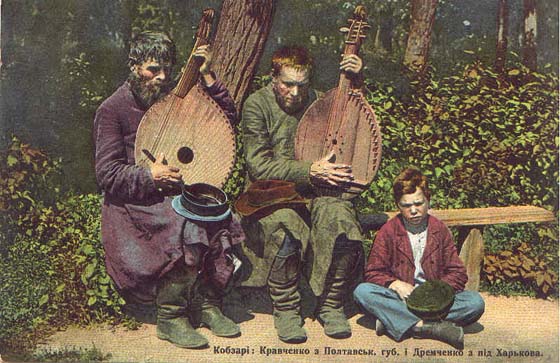
Kobzars. Photo taken in August 1902. Source: Wikimedia Commons
The diverse traditions of folk music passed down orally from generation to generation in the territory of what is now Ukraine were largely destroyed. In their place, the Soviet cultural authorities imposed a single ‘Ukrainian’ cliché: ‘folk choral singing’. In almost all towns and villages of the Ukrainian Soviet Republic, this template replaced authentic tradition. Whereas in traditional folk song, all members of an ensemble would sing with their distinct voice, each expressing their individuality, in folk choirs all voices had to blend. The result had to sound monolithic: no single voice was allowed to stand out. At the big folk music festivals staged to showcase the multi-ethnic state of the Soviet Union, all the choirs sounded almost the same.
In the late 1960s, Ukrainian music underwent a renaissance. Concerned that western rock bands were becoming increasingly attractive to Soviet youth, the Politburo in Moscow ordered that vocal-instrumental ensembles be formed throughout the republics. But in Ukraine, the plan backfired. Instead of attracting loyal Soviet musicians, a modern and original music scene emerged. Bands such as Vodohray, Kobza, Vizerunky shlyakhiv, Smerichka, Arnika, and dozens of others borrowed new rhythms and harmonies from music smuggled in from the West. Crucially, they also integrated motifs and instruments from Ukrainian folk music.
In his documentary Moustache Funk (2020), Vitali Bardetski shows how the Ukrainian bands of those years were part of a global phenomenon: the Ukrainian version of the Brazilian bossa nova-funk crossover, or of Afrobeat in West Africa. But under Soviet conditions Moustache Funk had no hope of finding a large audience, or even one beyond the borders of Ukraine, and during perestroika largely fell into oblivion.
This was not the only musical blossoming in Ukraine to come to an abrupt end during those years. The undisputed star of Ukrainian Estrada (pop-chanson) in the 1970s was the composer, poet and singer Volodymyr Ivasyuk, who wrote dozens of hits about love and the homeland that are still known throughout Ukraine today. The most famous is Chervona Ruta (Red Alpine Rose), which reached an audience of millions through the version sung by Sofiya Rotaru. In 1979, at the age of 30, Ivasyuk was found hanged in a forest. The authorities declared that he had committed suicide, but doubts persisted. Many believed that he had been murdered by the secret service. Ivasyuk’s funeral in Lviv turned into a mass protest against the Soviet government.
The next renaissance began with the ‘Chervona Ruta’ festival in Chernivtsi in 1989. The aim of the organisers was to inspire young people to sing and speak in their mother tongue. A few weeks before the scheduled date, the festival was banned. But after a petition to Leonid Kravchuk, then head of the ideological department of the Central Committee of the Communist Party of Ukraine (and later the first president of independent Ukraine), it was allowed to go ahead – although obstructed in every possible way by the authorities. People came from all over Ukraine. At the end of the festival, the public in the stadium stood up and sang ‘Ukraine Has Not Yet Perished’, a poem by Pavlo Chubynskyi set to music by Mykhailo Verbytsky in the 1860s, which became the Ukrainian national anthem in 1991.
Musical awakenings
Ukraine’s independence in 1991 seemed to open endless possibilities. ‘A teper use inakshe’ (‘Everything is different now’), sang the Eurodance duo Aqua Vita in 1997 in one of the biggest hits of that time. Music festivals sprang up all over the country, and local television broadcasted programmes with new, exclusively Ukrainian music of all styles: from pop ballads to hip-hop, from hard rock to reggae.
But the heyday of Ukrainian artists was short-lived. By the end of 1990s, the Ukrainian music industry was largely controlled by the bigger budgets of the Russian labels, radio and TV stations, which easily penetrated the market through subsidiaries and offshoots. The global music industry, in the form of major concert promoters and labels, also opened branches in Moscow and conquered the Ukrainian market from there.
Musicians from Ukraine faced a choice: either scrape by in their own country or go to Russia, where they could earn reasonable fees. More and more Ukrainian pop stars chose the latter and switched to singing in Russian, living between two countries and winning awards in Russia as Russian musicians. A hopeful sign for Ukrainian music came in 2004, when Ruslana won the Eurovision Song Contest with ‘Dyki tantsi’ (‘Wild Dances’), a catchy mix of pop and Carpathian folklore. It was the harbinger of political change: half a year later, the Orange Revolution erupted.
But real tectonic shifts began only after the Revolution of Dignity and Russia’s annexation of Crimea and invasion of the Donetsk and Luhansk in 2013–14. More and more Ukrainians realized that Russia’s influence was a threat. They began to take a greater interest in the history and culture of Ukraine and switched to the Ukrainian language. National consciousness experienced a massive boost. This led to a new interest in ‘native’ music.
The state paid increasing attention to the promotion of Ukrainian. The amendment to the Language Act established quotas for television and radio: first 25%, then 30% and finally 35% of all music broadcasted had to be sung in Ukrainian. At first, this led to stations playing a lot of second-rate material. But because of the quotas or despite them: Ukrainian songs gradually began to displace Russian ones from the top ten. For example, the song ‘Plakala’ (She Cried) by the group KAZKA, released in May 2018, rode high in the Ukrainian charts for months. In October, it even reached number nine in the global rankings of the music recognition service Shazam. The video now has five-and-half million views on YouTube.
The concert market also underwent radical change in the second half of the 2010s. Some western artists were afraid to perform in Ukraine because of the war, while many bands from Russia were denied entry because they supported the annexation of Crimea. This created new opportunities for Ukrainian musicians. Young bands could perform at much bigger venues. Some were soon playing to sold-out arenas. When the Atlas Weekend festival was first held in Kyiv in summer 2015, twenty thousand fans came to listen to local rock, hip hop, indie and electronic music. By 2021, the number had grown to over 600 thousand. The line-up was now international: the British bands The Prodigy and Kasabian (2017), the Belgian DJ Lost Frequencies and British electronic music duo The Chemical Brothers (2018), the American DJ duo The Chainsmokers and British singer-songwriter Liam Gallagher (2019) performed alongside Ukrainian headliners such as BoomBox, Okean Elzy, The Hardkiss and DakhaBrakha.
Music of almost all possible genres flourished in Ukraine. Any sophisticated listener could find something interesting: indie (the brightest representatives include Latexfauna, Tik Tu, Blooms Corda), rock (O.Torvald, The Unsleeping, Love’n’Joy), heavy music of all kinds (Space Of Variations, Motanka, Pokruch), mainstream and underground hip-hop (Kalush, Freel, Kurgan), experimental electronic (Heinali, Poly Chain, Monoconda), modern and traditional jazz (Hyphen Dash, Dennis Adu), and more.
Many Ukrainian musicians continue to weave elements of local culture into their work. ONUKA, for example, combines electropop with traditional instruments. In some concerts they have been accompanied by a whole orchestra of folk instruments, playing to sold-out halls in front of thousands of people. The band Ragapop recorded an EP with songs based on poems by the nineteenth-century Galician writer Ivan Franko, leading to these classic verses being sung in a mighty chorus at the group’s concerts.
Some labels have specialized in snatching music from oblivion and rediscovering artists who could have become international stars, had conditions been different. One such gem is Kobzareva Duma, a recording of a concert by the Shapoval Sextet from 1976, interweaving psychedelic jazz with traditional Ukrainian motifs. Another is Valentina Goncharova, who conducted avant-garde experiments with the electric violin and a tape recorder in the 1980s and 1990s.
A number of Ukrainian artists have broken through onto the international stage. This is especially true of the ethno band Dakhabrakha. Like no one else, they have opened the eyes, ears and hearts of a global audience to the Ukrainian spirit. The band has toured the US 18 times in seven years, alongside countless other worldwide journeys and appearances. Other Ukrainian artists to have reached western European audiences with their gigs include the rapper alyona alyona and the singer-songwriter Postman, while the rock band Stoned Jesus even toured South America, where they have gained a passionate fanbase.
Musicians at war, music at war
A few days after the full-scale war began, Andriy Khlyvnyuk recorded a short video at the deserted Sophia Square in the centre of Kyiv. He was on patrol with his unit, wearing camouflage. In the video Khlyvnyuk sings the first verse of the song ‘Oy u luzi Chervona kalyna’ (‘Oh, the red viburnum in the meadow’). The song was written in its current version in 1914 and was popular among the Sich Riflemen, a unit of the Army of the Ukrainian People’s Republic (1917–1920) during the First World War. It is a patriotic march in the style of a folk song:
Oh, in the meadow a red viburnum has bent down low.
Our glorious Ukraine is in sorrow.
And we’ll take that red kalyna and raise it up,
And we’ll take our glorious Ukraine and, hey hey, cheer it up!
Khlyvnyuk’s video went viral. Within a few weeks, the song was everywhere: street musicians sang it, as did children in the playgrounds and soldiers at the front; remixes were played on the radio and as mobile ringtones. The South African musician The Kiffness ensured international distribution by creating a remix that the Ukrainian skating pair Oleksandra Nazarova and Maksym Nikitin used for their free skate at the World Championships in Montpellier in March 2022. When Khlyvnyuk was in the hospital after his injury, he was contacted by none other than Pink Floyd frontman Dave Gilmour, who asked permission to use the video. The result was ‘Hey hey, rise up!’, the first Pink Floyd song in 28 years (as of December 2022, the charity single has raised more than $600,000 for humanitarian efforts in Ukraine).
After his recovery in April, Andriy Khlyvnyuk returned to duty. With his unit, he went to the newly liberated towns near Kyiv: brought humanitarian goods and helped remove from the streets the bodies of civilians murdered by Russian soldiers. Since then, Andriy has been raising money for armoured ambulances and combat drones. He also found time for a series of charity shows in Europe with Boombox. Afterwards, Khlyvnyuk again returned to the front.
Many other musicians have enlisted in the army. They are on the front line, weapons in hand, building up defences and transporting aid. They include Yevhen Halych, frontman of the rock band O. Torvald, who had previously headlined the biggest festivals in the country. Or the country singer-songwriter Sasha Boole, who had toured in Europe. Or Pavlo Nechytailo from the duo Zapaska, a poet and researcher of the antiquities of Podillia. Or Stasik, an avant-garde singer and actress who now serves as a paramedic. Or Sashko Polozhynskiy, the leader of the rap-rock band Tartak, whose song ‘I don’t want to be a hero of Ukraine, my country doesn’t appreciate heroes’ became an anthem of Orange Revolution in 2004.
A completely different kind of contribution to the defence of Ukraine is being made by musicians who are using their fame to collect donations and promote international solidarity. In 2022, Dakhabrakha again toured the US twice (around 50 gigs in total) and gave dozens of concerts in Europe, including a second appearance at the Glastonbury Festival, this time on the main stage. At each gig, the musicians talk about the war and call for heavy weapons to be provided to Ukraine; and each time a significant part of the band’s fee goes to charities in Ukraine. Pop singer Jamala, who won the Eurovision Song Contest for Ukraine in 2016 with the song ‘1944’ (the year of the deportation of the Crimean Tatars), collected 90 million euros in donations for Ukraine and its armed forces at benefit concerts in the first two months of the war alone. This puts her on a par with the largest charitable foundations in the country.
Kalush Orchestra won the Eurovision Song Contest 2022 with ‘Stefania’. The song, dedicated to the frontman’s mother, mixes rap and pop with vocals and instruments from traditional folk music. During the performance in the final on 14 May 2022, band leader Oleh Psyuk called on the world to save the soldiers and civilians trapped in the Azovstal steel plant in Mariupol, where they were under siege from the Russian army.
Except for this, Kalush Orchestra had observed the rules of the Song Contest and refrained from explicit references to the war. But the day after the final, the band released a video for the song, showing bombed-out streets and female soldiers rescuing children from destroyed houses in Bucha, Irpin, Borodyanka and Hostomel, all on the outskirts of Kyiv. After taking the children to their mothers in refugee shelters, they board the train to the front. The video ends with images of a burning Russian tank and a young girl holding a Molotov cocktail. Two weeks after the final, Kalush Orchestra auctioned off the trophy and raised $900k, which they donated to the Ukrainian army.
Despite all odds
But it’s not just world-renowned bands that are contributing to the war effort. All Ukrainian musicians not serving in the army themselves are helping it in any way they can, by collecting money and buying cars, radios, first-aid kits and uniforms. They know that not just their own survival, but the survival of Ukrainian music is at stake.
After the initial shock, many Ukrainian musicians felt the urge to create. One of the first was Anton Slepakov, co-founder of the band Vagonovazhatye (VGNVZ), a poet and legend of the alternative scene. Accompanied by Andriy Sokolov, he released an album in March entitled warnyakannya (‘war talk’), which combines spoken word with electronic music. The texts evoke small yet meaningful snapshots of war: a city without children, scotch tape on the windows of the railway station, two sets of keys from flats in Donetsk and Mariupol, a dog named after the town of Irpin, a bottle of wine saved for victory day. Slepakov was followed by dozens of artists who process current events in new releases every week, transforming emotions into words and music. They rage, curse the enemy, grieve, inspire to fight, even joke a little. That is, they live through war in the same way as every Ukrainian.
Khrystyna Soloviy, well known for her tender love ballads, sings in ‘Ukrains’ka Ljut’ (Ukrainian Anger) to the tune of Bella Ciao: ‘And those damned executioners / we burn them mercilessly’. Palindrome screams: ‘We are more together now than ever! Go home, your rusty Russian shackles are coming off.’ In a song by Oi FUSK, entitled ‘For Whom the Bell Tolls’, the artist raps: ‘My house has no more walls, and I am not alone in this, flood, the rivers are once again coloured with blood’. The track was written the day after his house was destroyed by a Russian missile. OTOY (Vyacheslav Drofa), a rising star of Ukrainian rap, joined the Azov regiment and in between battles managed to record new EP ‘Okolofront’ (Near Front). In it he declares: ‘This is my new everyday life, my new everyday life is war. Either in the ground here or ready to spit bullets every day.’
The Ukrainian music industry will have to be rebuilt from ruins. But this is the least that interests artists now. For the next rebirth to be possible, they must first survive physically.
The Musicians Defend Ukraine foundation supports musicians and other people from the music industry fighting on the front lines or volunteering in other capacities to defend Ukraine. Organised by members of the rock band Love’n’Joy, owners of Shpytal Records music studio and Kontrabass Promo concert agency, the foundation raises funds and provides artists with necessary tactical items such as body armour, first aid kits, surveillance drones, thermal monoculars, walkie-talkies, vehicles etc.
Published 25 January 2023
Original in Ukrainian
Translated by
Annegret Becker, Edward Maltby
First published by Osteuropa 6–8/2022 (German version); Eurozine (extended English version)
Contributed by Osteuropa © Sergii Cane; Osteuropa; Eurozine
PDF/PRINTPublished in
In collaboration with
In focal points
Newsletter
Subscribe to know what’s worth thinking about.
Related Articles
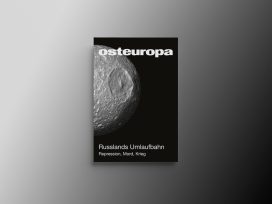
Russia’s orbit
Osteuropa 4/2024
Repression, murder, war: on the logic driving the Putin regime toward ever-greater excesses of violence. Featuring Yuri Andrukhovych on the Russian colonial empire – the only ever to have tried to reconquer a former possession. Also: articles on Navalny, and on what next for Georgia?
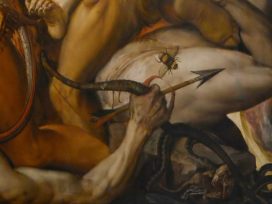
The difference between knowing from distance that war is being waged and living that reality couldn’t be more extreme. But can awareness of multiple repercussions turn protective disassociation from violence into active solidarity? ‘The Most Documented War’ symposium in Lviv, Ukraine, provides valuable pointers regarding engagement and responsibility.

